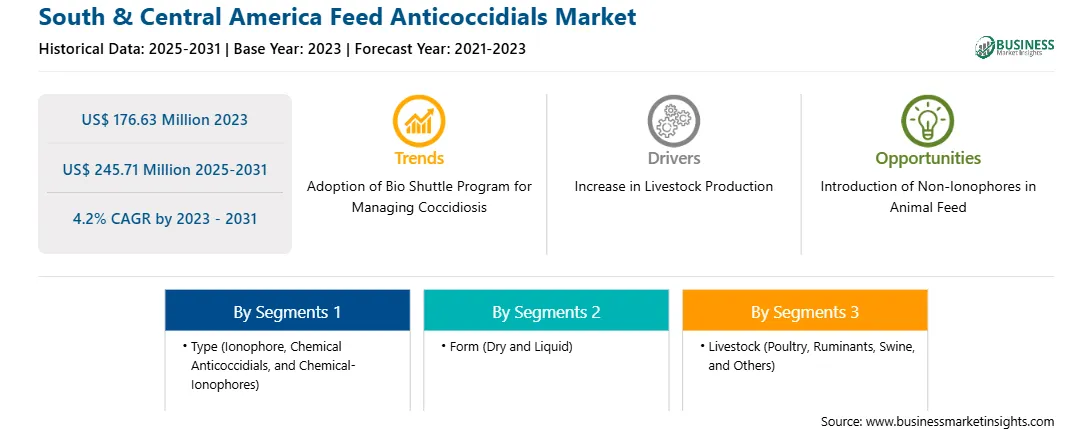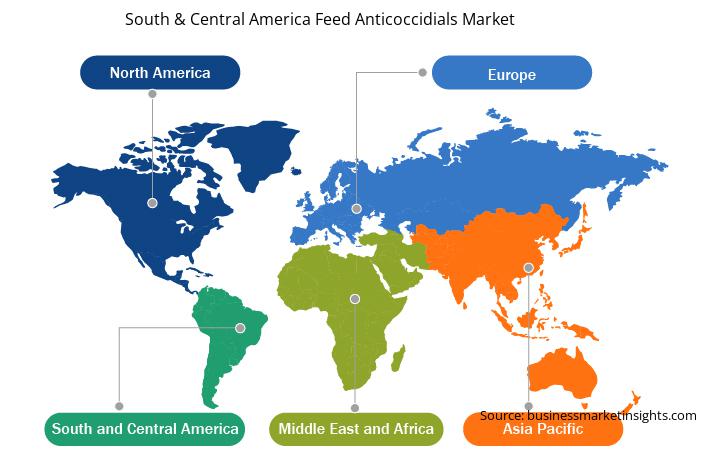The South & Central America feed anticoccidials market was valued at US$ 176.63 million in 2023 and is expected to reach US$ 245.71 million by 2031; it is estimated to record a CAGR of 4.2% from 2023 to 2031.
Ionophores have some degree of antibacterial activity and fit the classical definition of an antibiotic. All ionophores are approved for broiler chicken production, but not all are approved or safe for turkeys. Salinomycin and narasin are quite toxic for turkeys and equines. As ionophores are antibiotics, they should not be used continuously but instead rotated with different anticoccidials. Moreover, there are stringent regulations on using antibiotics in feed as an additive. Thus, manufacturers are developing different anticoccidials that cannot be called antibiotics.
Non-ionophores are compounds produced by chemical synthesis; thus, they fall under the category of chemical anticoccidials. They destroy coccidia by cidal activity or suppress coccidia by static activity. They have no known antibacterial activity; hence, they are not considered as an antibiotic. Non-ionophores are products containing nicarbazin, zoalene, amprolium, clopidol, decoquinate, robenidine and diclazuril. EW Nutrition—an agribusiness company that creates solutions that bring reliable benefits with reduced need for antibiotics, especially in feed—has developed non-ionophores for animal feed. Owing to all these factors, livestock farmers concerned about using antibiotics in animal feed can opt for non-ionophore anticoccidials. Therefore, the introduction of non-ionophore in animal feed is expected to offer lucrative opportunities for the feed anticoccidials market during the forecast period.
The Brazil feed anticoccidials market is driven by its massive livestock industry and growing demand for animal protein. The poultry industry in the country heavily relies on anticoccidials to prevent and control coccidiosis. Brazil produces over 11.79 metric tons of chicken meat annually, with approximately 3.62 metric tons exported to over 150 countries. The country's cattle herd, numbering approximately 215 million head as of 2023, also contributes to the demand for feed anticoccidials. Brazil's beef production reached 10.5 million tons in 2022, with exports accounting for about 25% of this volume.
Ionophores dominate the market, followed by chemical anticoccidials, based on anticoccidials market. Brazil's strict regulations on anticoccidial use, overseen by the Ministry of Agriculture, Livestock, and Food Supply (MAPA), ensure product safety and efficacy while aligning with international standards. This regulatory framework supports the country's position as a trusted global supplier of animal protein products. These factors drive the demand for feed anticoccidials in the country.
Strategic insights for the South & Central America Feed Anticoccidials provides data-driven analysis of the industry landscape, including current trends, key players, and regional nuances. These insights offer actionable recommendations, enabling readers to differentiate themselves from competitors by identifying untapped segments or developing unique value propositions. Leveraging data analytics, these insights help industry players anticipate the market shifts, whether investors, manufacturers, or other stakeholders. A future-oriented perspective is essential, helping stakeholders anticipate market shifts and position themselves for long-term success in this dynamic region. Ultimately, effective strategic insights empower readers to make informed decisions that drive profitability and achieve their business objectives within the market. The geographic scope of the South & Central America Feed Anticoccidials refers to the specific areas in which a business operates and competes. Understanding local distinctions, such as diverse consumer preferences (e.g., demand for specific plug types or battery backup durations), varying economic conditions, and regulatory environments, is crucial for tailoring strategies to specific markets. Businesses can expand their reach by identifying underserved areas or adapting their offerings to meet local demands. A clear market focus allows for more effective resource allocation, targeted marketing campaigns, and better positioning against local competitors, ultimately driving growth in those targeted areas.South & Central America Feed Anticoccidials Strategic Insights

South & Central America Feed Anticoccidials Report Scope
Report Attribute
Details
Market size in 2023
US$ 176.63 Million
Market Size by 2031
US$ 245.71 Million
CAGR (2023 - 2031) 4.2%
Historical Data
2021-2023
Forecast period
2025-2031
Segments Covered
By Type
By Form
By Livestock
Regions and Countries Covered
South & Central America
Market leaders and key company profiles
South & Central America Feed Anticoccidials Regional Insights

The South & Central America feed anticoccidials market is segmented based on type, form, livestock, and country. Based on type, the South & Central America feed anticoccidials market is segmented into ionophore, chemical anticoccidials, and chemical-ionophores. The ionophore segment held the largest market share in 2023.
In terms of form, the South & Central America feed anticoccidials market is bifurcated into dry and liquid. The dry segment held a larger market share in 2023.
Based on livestock, the South & Central America feed anticoccidials market is segmented into poultry, ruminants, swine, and others. The poultry segment held the largest market share in 2023.
Based on country, the South & Central America feed anticoccidials market is segmented into Brazil, Argentina, and the Rest of South & Central America. Brazil dominated the South & Central America feed anticoccidials market share in 2023.
Phibro Animal Health Corp, Zoetis Inc, Kemin Industries Inc, Elanco Animal Health Inc, Huvepharma EOOD, Impextraco NV, and Virbac SA. are some of the leading players operating in the South & Central America feed anticoccidials market.
The South & Central America Feed Anticoccidials Market is valued at US$ 176.63 Million in 2023, it is projected to reach US$ 245.71 Million by 2031.
As per our report South & Central America Feed Anticoccidials Market, the market size is valued at US$ 176.63 Million in 2023, projecting it to reach US$ 245.71 Million by 2031. This translates to a CAGR of approximately 4.2% during the forecast period.
The South & Central America Feed Anticoccidials Market report typically cover these key segments-
The historic period, base year, and forecast period can vary slightly depending on the specific market research report. However, for the South & Central America Feed Anticoccidials Market report:
The South & Central America Feed Anticoccidials Market is populated by several key players, each contributing to its growth and innovation. Some of the major players include:
The South & Central America Feed Anticoccidials Market report is valuable for diverse stakeholders, including:
Essentially, anyone involved in or considering involvement in the South & Central America Feed Anticoccidials Market value chain can benefit from the information contained in a comprehensive market report.